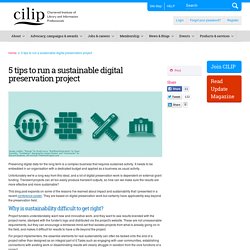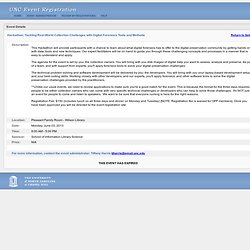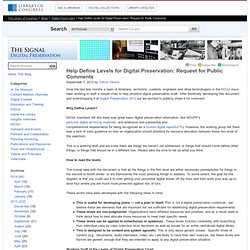

Ipres2015. Consortium issues first public software release. Online Resources. If you are new to the world of digital preservation, you may be feeling overwhelmed by the multitude of technical terms and professional practices to contend with, and the fact that standards never seem to stay in place for very long.

Fortunately, there are many resources related to digital preservation available on the internet. Unfortunately, the large amount of websites, hyperlinks and sub-sections can exacerbate those confounded feelings. In order to help the novice, nerd or perplexed archivist wanting to learn more, Greatbear compiled a useful selection of (by no means exhaustive) resources to guide your hand. Ultimately if content is to be useful it does need to be curated and organised. Bear in mind that individual websites within the field tend to be incredibly detailed, so it is worth having a really good explore to find the information you need!
Fields of interest: Digital Preservation. Julia Brungs sur Twitter : "A UNESCO Expert Meeting on Digital Preservation Challenges held in Paris last week:... Parsimonious Preservation - (another) different approach to digital information management - greatbear analogue and digital media. We have been featuring various theories about digital information management on this blog in order to highlight some of the debates involved in this complex and evolving field.

To offer a different perspective to those that we have focused on so far, take a moment to consider the principles of Parsimonious Preservation that has been developed by the National Archives, and in particular advocated by Tim Gollins who is Head of Preservation at the Institution. In some senses the National Archives seem to be bucking the trend of panic, hysteria and (sometimes) confusion that can be found in other literature relating to digital information management. The advice given in the report, ‘Putting Parsimonious Preservation into Practice‘, is very much advocating a hands-off, rather than hands-on approach, which many other institutions, including the British Library, recommend. Proceedings-version%201. iPres-Proceedings-v006. Image uploaded by @HS_UserImages (Hootsuite User Image) 5 tips to run a sustainable digital preservation project.
Why is sustainability difficult to get right?

Project funders understandably want new and innovative work, and they want to see results branded with the project name, stamped with the funder's logo and distributed via the project's website. These are not unreasonable requirements, but they can encourage a blinkered mind-set that isolates projects from what is already going on in the field, and makes it difficult for results to have a life beyond the project. #Ipres2014 top 10. Heide Estes sur Twitter : Looky here, it's really cool. #digipal... File Format Comparison Projects: Still Image and Audio-Visual Working Groups - Federal Agencies Digitization Guidelines Initiative.
The FADGI Still Image and Audio-Visual Working Groups are exploring file formats for still images and video.

Two explorations are focused on reformatting, e.g., digitizing documents, books, maps, and photographs as still images, and digitizing videotapes (mostly analog, sometimes digital) as file-based video. These two comparisons employ similar, matrix-based tools to make comparisons relevant to preservation planning. The matrixes compare a limited number of formats in terms of roughly forty factors, grouped under the following general headings: Sustainability FactorsCost FactorsSystem Implementation Factors (Full Lifecycle)Settings and Capabilities (Quality and Functionality Factors) Raster Still Images for Digitization: A Comparison of File Formats Digital File Formats for Videotape Reformatting Meanwhile, a third exploration examines born digital video.
Creating and Archiving Born Digital Video. A Digital Preservation Conference. Open Planets Foundation. FITS is a classic case of a great digital preservation tool that was developed with an initial injection of resource, and subsequently the creator (Harvard University) has then struggled to maintain it.

But let me be very clear, Harvard deserves no blame for this situation. They've created a tool that many in our community have found particularly useful but have been left to maintain it largely on their own. Wouldn't it be great if different individuals and organisations in our community could all chip in to maintain and enhance the tool? Wrap new tools, upgrade outdated versions of existing tools, and so on? Web Archiving Bibliography 2013, Page: Title Page. Home - COPTR - Confluence. Fifty Digital Preservation Activities You Can D... Event Registration System.
This Hackathon will provide participants with a chance to learn about what digital forensics has to offer to the digital preservation community by getting hands on with data, tools and new techniques.

Our expert facilitators will be on hand to guide you through these challenging concepts and processes in a manner that is easy to understand and apply. The agenda for the event is set by you: the collection owners. You will bring with you disk images of digital data you want to assess, analyze and preserve. As part of a team, and with support from experts, you'll apply forensics tools to solve your digital preservation challenges. The technical problem solving and software development will be delivered by you: the developers. Preserving the Past. A video overview of the collaborative digitisation project between the University of Warwick, Queen Mary University, London and Waddesdon Manor Bringing together knowledge and expertise from several departments, researchers from the University of Warwick and Queen Mary have helped Waddesdon Manor, a National Trust country house in Buckinghamshire, to open up part of its internationally famous collection.

Now academics and the wider public can view its treasures for free, online. Download “As with stomachs, we should pity minds that do not eat.” Victor Hugo, Les Misérables French history, specifically that surrounding the lead up to the 1832 June Rebellion, is garnering its fair share of public attention at present as Tom Hooper’s cinematic adaption of the hit musical Les Misérables, itself based upon the novel by Victor Hugo, arrives in British cinemas. British interest in this period of French history is not, however, a 21st-century phenomenon.
Monster Black Hole Is Biggest Ever Found. Astronomers have discovered what may be the most massive black hole ever known in a small galaxy about 250 million light-years from Earth, scientists say.

The supermassive black hole has a mass equivalent to 17 billion suns and is located inside the galaxy NGC 1277 in the constellation Perseus. It makes up about 14 percent of its host galaxy's mass, compared with the 0.1 percent a normal black hole would represent, scientists said. "This is a really oddball galaxy," said study team member Karl Gebhardt of the University of Texas at Austin in a statement. "It's almost all black hole. This could be the first object in a new class of galaxy-black hole systems.
" The giant black hole is about 11 times as wide as the orbit of Neptune around our sun, researchers said. The practitioners have spoken: "We need better characterisation!" On Monday I was asked to speak at an experts workshop aimed at steering developments in preservation services on the Reponet+ Project (part of JISC Innovation Zone). For my presentation ( "Pain Points for preservation workflows/services in repositories" ) I had a look at the growing collection of practitioner sourced preservation challenges we've been accumulating on the OPF wiki . I've attempted to pull together these preservation issues into key themes that might be useful in steering the development of future digital preservation tools and services. Pain points for preservation services / workflows in repositories.
Designing Storage Architectures 2012 Meeting & Events. Back to Meetings & Events Designing Storage Architectures for Digital Collections September 20-21, 2012 Washington, DC.

Moving, singing and dreaming with a Chrome experiment from Cirque du Soleil. Help Define Levels for Digital Preservation: Request for Public Comments. Over the last few months a team of librarians, archivists, curators, engineers and other technologists in the NDSA have been working to draft a simple chart to help prioritize digital preservation work.

After iteratively developing this document and workshopping it at Digital Preservation 2012 we are excited to publicly share it for comment. Why Define Levels? When 900 years old, you reach... Look as good, you will not... I think that was the quote we were looking for? Ok, maybe not but If I mention the word DROID you might figure the right one out! Tenuous links over, in Digital Preservation today we’ve released a new version of the DROID (Digital Record and Object Identification) tool – version 6.1. We’ve spoken about the tool before when I blogged about the PRONOM and DROID user consultation we held at The National Archives last year. The day resulted in a consultation wiki where contribution is invited by all members of the public with an interest in a potential DROID 7. The wiki page lists requirements that users of the tool have for DROID 7 and all future versions.
Institutional Repositories and Digital Preservation: Assessing Current Practices at Research Libraries. D-Lib Magazine May/June 2011 Volume 17, Number 5/6Table of Contents Institutional Repositories and Digital Preservation: Assessing Current Practices at Research Libraries doi:10.1045/may2011-yuanli Printer-friendly Version Abstract In spring 2010, authors from the University of Massachusetts Amherst conducted a national survey on digital preservation of Institutional Repository (IR) materials among Association of Research Libraries (ARL) member institutions. Introduction Digital preservation is a significant problem facing libraries. Perhaps an even greater threat than the deterioration of storage media is technological obsolescence. Open access to electronic theses soon to be commonplace.
Doctoral theses can attract significant attention when made openly accessible in electronic form according to the respondents of a sector-wide survey of information professionals. The Jisc-funded survey gives a clearer picture of progress toward electronic thesis deposit in the UK, and how universities are achieving it. The respondents to the survey were library and repository staff from 144 higher education institutions – and their responses suggested that 81% of their organisations will be providing open access to doctoral theses in five years time. Search results. E-Journals: Archiving and Preservation Briefing paper. Libraries have in the past assumed preservation responsibility for material they collect, while publishers have supplied the material they need. These well understood divisions of labour do not work in the digital environment and especially so when dealing with licensed e-journals.
The crucial difference between licensing access to an e-journal, as opposed to purchasing and then owning a print journal, is that, unless there are explicit and legally binding arrangements for archiving, it cannot be guaranteed that online access will continue indefinitely. Despite these major concerns, the trend towards e-only access is continuing at a rapid rate.